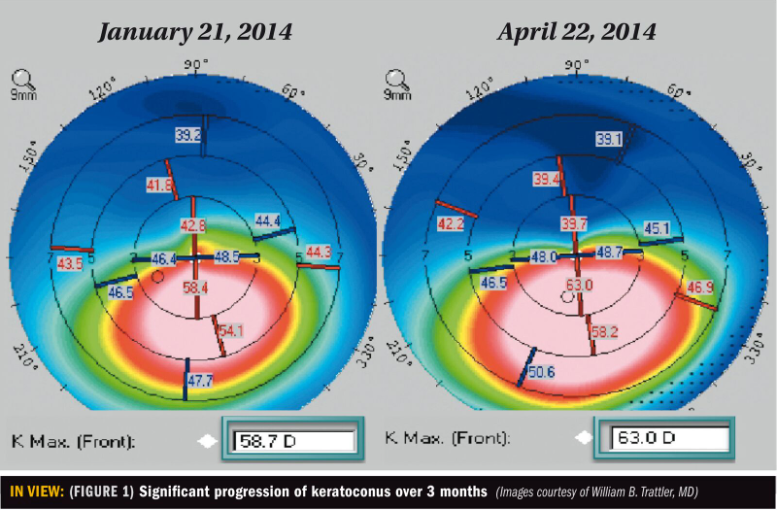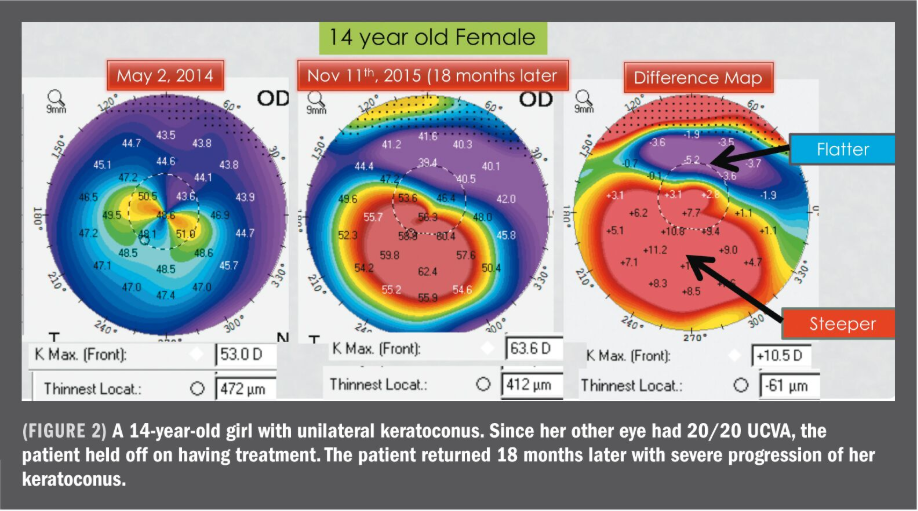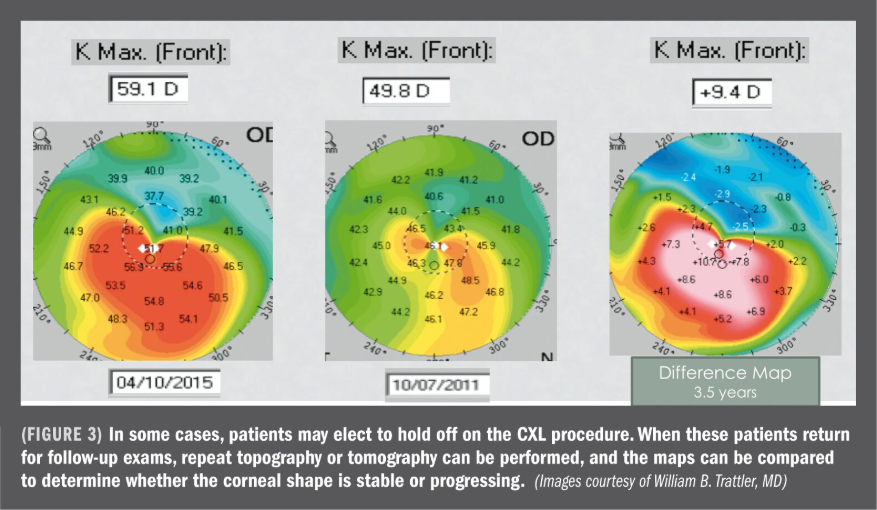Article
Determining best time for crosslinking
Author(s):
: (FIGURE 1) Significant progression of keratoconus over 3 months (Images courtesy of William B. Trattler, MD)

(FIGURE 2) A 14-year-old girl with unilateral keratoconus. Since her other eye had 20/20 UCVA, the patient held off on having treatment. The patient returned 18 months later with severe progression of her keratoconus.

(FIGURE 3) In some cases, patients may elect to hold off on the CXL procedure. When these patients return for follow-up exams, repeat topography or tomography can be performed, and the maps can be compared to determine whether the corneal shape is stable or progressing. (Images courtesy of William B. Trattler, MD)

- Patients of any age may be considered as a candidate for corneal crosslinking to treat keratoconus.
- Patients 8 years old and over can have very good results with this treatment.
- Making the diagnosis as early as possible is important, and typically requires corneal topography or tomography
Reviewed by William B. Trattler, MD
Corneal crosslinking (CXL) has become a widely accepted treatment for patients with keratoconus in all age groups. The procedure has been shown to stabilize the corneal shape, and many patients can experience improvement in corneal shape following crosslinking.
One challenge is determining when a patient should undergo the CXL procedure.
While the rate of progression in adults is variable, research has shown that progression of keratoconus occurs more rapidly in children and young adults. With this in mind, clinicians need to help patients decide when to undergo the CXL procedure.
For children, the evidence suggests that early treatment is in their best interest, as this can prevent the condition from rapidly progressing.
William B. Trattler, MD, a cornea specialist at the Center for Excellence in Healthcare, Miami, believes that patients of any age can be treated with CXL, and that patients age 8 and over can do very well with the treatment.
Dr. Trattler pointed out that the rate of progression in children can be surprisingly fast.
For example, the patient in Figure 1 was referred for consultation for CXL. The patient’s mother scheduled the CXL procedure for 3 months in the future.
When the patient returned for treatment, the Pentacam maps demonstrated rapid progression of keratoconus over the 3 months.
Dr. Trattler also shared a second case, of a 14-year-old girl with unilateral keratoconus (Figure 2). Since her other eye had 20/20 UCVA, the patient held off on having treatment. The patient returned 18 months later with severe progression of her keratoconus.
With these cases in mind, Dr. Trattler pointed out that for children and young adults, he attempts to schedule the treatment in weeks rather than months.
Imaging is crucial for early diagnosis
Making the diagnosis of keratoconus in a child as early as possible is very important.
The diagnosis of mild to sometimes even moderate keratoconus requires corneal topography or tomography, because patients with mild to moderate keratoconus may have a completely normal slit lamp exam.
Findings such as corneal striae or an iron line occur when keratoconus is very advanced, and significant vision loss has already occurred. When keratoconus is diagnosed with topography or tomography, the patient and family can be educated on the benefits of crosslinking.
In some cases, patients may elect to hold off on the CXL procedure. When these patients return for follow up exams, repeat topography or tomography can be performed, and the maps can be compared to determine whether the corneal shape is stable or progressing (Figure 3).
Can keratoconus still progress?
While crosslinking is highly successful, a small percentage of patients may still experience progression.
Therefore, following the CXL procedure, patients should continue having semiannual or annual exams where the vision and corneal shape is monitored.
The expectation is that the corneal shape should remain stable or improve over time.
However, if further worsening of keratoconus is identified despite undergoing cross-linking, patients can be scheduled for a second (repeat) CXL procedure.
Typically, the second procedure is quite effective in stabilizing the cornea.
One risk factor for needing a second CXL procedure is chronic eye rubbing, so patients with keratoconus should be advised on the importance of refraining from eye rubbing. If needed, patients can be prescribed topical ocular allergy medications.
Ocular surface disease should also be identified, and treated if present.
Conclusion
Patients of any age may be considered as a candidate for corneal crosslinking to treat keratoconus. Patients 8 years old and over can have very good results with this treatment.
Making the diagnosis as early as possible is important, and this typically requires corneal topography or tomography. Once a child is diagnosed with keratoconus, CXL should be scheduled. It is important to educate patients on the importance of avoiding eye rubbing, and if needed, to prescribe ocular allergy and dry eye medications to help improve the comfort of the eye and reduce the urge to rub.
Overall, the availability of CXL provides a significant opportunity to treat patients at an early time point to prevent severe vision loss.
Disclosures:
William B. Trattler, MDDr. Trattler is a speaker for Oculus, a speaker and consultant for Avedro, and has a fi nancial interest in CXLO and Avedro.
Newsletter
Don’t miss out—get Ophthalmology Times updates on the latest clinical advancements and expert interviews, straight to your inbox.





